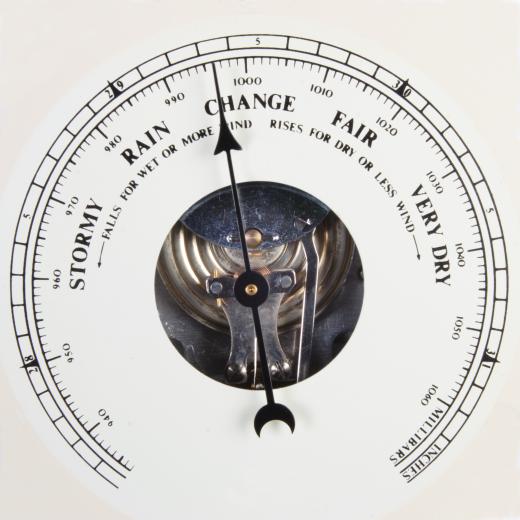What Is a Gas Manometer?
A gas manometer is a device used to measure the pressure of a gas. Manometers may be either closed-tube or open-tube and may use water, mercury, or another liquid to measure pressure. The simplest laboratory gas manometer consists of a U-shaped glass or plastic tube connected to a container of pressurized gas at one end and filled partially with liquid. Digital manometers are also sold, and are widely used for checking gas pressure for household appliances.
Pressurized gas exerts a force on its container. For example, a balloon will stretch when blown up — the interior air pressure becomes greater than the exterior air pressure and forces the stretchy material of the balloon outward. A gas manometer uses this principle to measure the pressure of a gas in a container against atmospheric pressure or against a vacuum.

An open-tube gas manometer consists of a container filled with pressurized gas and connected to one end of a U-shaped tube, which is open at the other end. The side of the tube furthest from the gas container is calibrated with markings for measurement. Liquid mercury or water is used to fill the bottom part of the U-tube.
If there is a difference in pressure between the gas and the atmosphere, the liquid in the U-tube will be forced in one direction. For example, if the gas in the container is at a higher pressure than the atmosphere, the liquid will be forced down the U-tube away from the container. It will rise along the calibrated marks towards the open end, providing a measurement that can be used to deduce the pressure of the gas. If atmospheric pressure is greater, that pressure will force the liquid towards the container, causing the level of liquid to drop along the calibrated marks.
Since both atmospheric pressure and gas pressure are acting on the liquid in the tube, both must be factored in when finding the pressure of the contained gas. When the gas pressure is greater than atmospheric pressure, the gas is not only pushing the liquid upwards in the opposite tube, it is pushing the air above it as well. This means that atmospheric pressure must be added to the measurement of the height of the liquid to obtain the true gas pressure. If the gas pressure is lower than atmospheric pressure, the opposite holds: the height measurement is subtracted from the atmospheric pressure to find the true gas pressure.
A closed-tube manometer uses the same setup, but with a closed end that holds a vacuum instead of being open to the air. This type of gas manometer avoids the issue of atmospheric pressure. Since no other source of pressure acts on the opposite end of the tube, the height of the liquid is solely determined by the pressure of the contained gas. The gas will force the liquid a certain distance up the tube into the vacuum, at which point the pressure can be read.
AS FEATURED ON:
AS FEATURED ON:











Discuss this Article
Post your comments